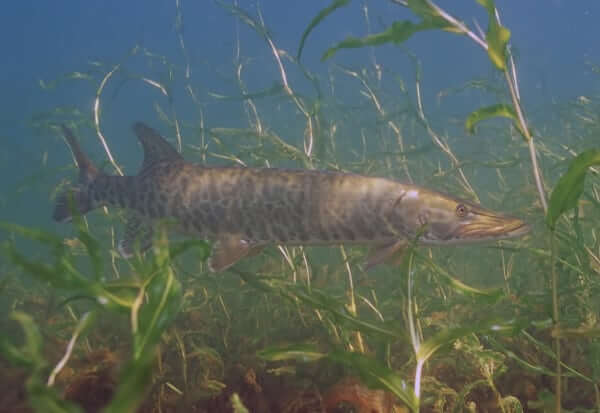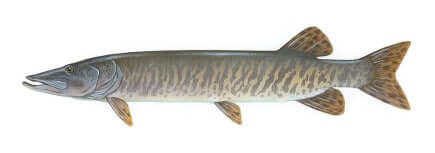Muskellunge

Meet the muskellunge, affectionately known as the muskie or the fish of 10,000 casts. This giant predator can be found in many regions of the Ottawa River — if you know where to look.
by Andrea Hill
Appearance: Muskies are large, streamlined fish that look like large pikes. “It’s got big jaws with sharp teeth and a really thick, muscular body,” describes Noel Alfonso, senior research assistant with the research services division of the Canadian Museum of Nature. “It’s really built for speed, it’s built to be an ambush predator. It’s a really super impressive animal.”
Size: Muskies are the second-largest fish in the Ottawa River after the sturgeon. Anglers consider muskies to be trophy catches if they are longer than 101 cm, but so many Ottawa River fish exceed this that the river’s muskies can only be kept if they measure 137 cm or more. In 1997, angler Bill Craig caught a 157.5 cm muskie that made it’s way into the Freshwater Fishing Hall of Fame. Craig’s catch remains the biggest muskie caught in the river to date.
Age: Researchers estimate muskies’ age based on their age based on size. Muskies in the Ottawa River are believed to live up to 30 years.
Distribution: Muskies are found in all five Great Lakes and some of the connecting river systems including the St. Lawrence, which joins up with the Ottawa River in Montreal. The Ottawa River is famous amongst anglers for its large populations of impressive-sized fish that can be found in waters south of Lake Temiskaming, about 150 km north of North Bay.
Habitat: Muskies live and spawn in slow-moving and heavily vegetated waters such as wetlands, river lines and reservoirs. The large fish are believed to return to the same spawning sites each year, which means that loss of flood-plain habitats could threaten the reproductive future of this species.
Diet: Muskies are piscivores that eat other fish such as whitefish, mooneye, shiners, suckers, catfish and young sport fish.
Predators: Though muskies enjoy a spot at the top of the food chain, they are targeted by fishermen and can be attacked by parasites. The fish are often parasitized by the silver lamprey — a problem more prevalent in the Ottawa River than in other parts of Ontario.
Fun facts: Fishermen often refer to the muskie as the “fish of 10,000 casts” because they can be so difficult to catch. “It takes a lot of dedication, a lot of work and a bit of luck to catch one,” Alfonso says. “It’s an elusive target, they’re hard to catch for the average angler and you get a real rush when you do catch one because they’re really strong and they put up a tremendous fight.”

